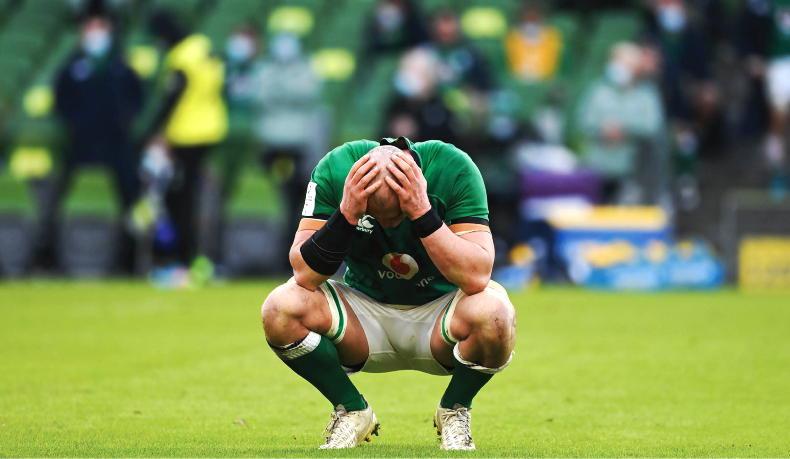An old Guinness advertisement used to claim that that “88.2 percent of statistics are made up on the spot” and, in less technologically enlightened times, it was hard to prove or disprove that.
Now, thanks to the advances of the modern world, we have all manner of data and this has led to an explosion of numbers-based sports analysis but, of course, the bare information is useless without context.
On Monday, in the wake of the second round of Six Nations Championship fixtures, ESPN published a vast array of statistics, showing how the countries had performed in the opening games. From an Irish point of view, what stands out are the two points on the board – leaving them second from bottom – and, while a case could be made that the defeats to Wales and France could have been victories with a bit more good fortune, the underlying figures show that the table isn’t telling lies.
Irish players have made 322 runs for a total of 901 metres and both of these are the highest among the six countries, but the average is just 2.8 metres per run – only Wales (2.4) have lower while France’s 4.5 leads the way. Similarly, Ireland have made 454 passes to 214 for France, but Andy Farrell’s side have only completed six offloads (moving the ball before a tackle can be completed) compared to 21 for Fabien Galthié’s table-toppers. That kind of ‘sterile dominance’ was best summed up in Sunday’s closing stages as Ireland, needing to advance the ball to a position from where a game-winning drop-goal could be attempted, were unable to penetrate the well-drilled French defence, driven back from their opponents’ 10-metre line to their own.
Eventually, France forced a turnover and victory was theirs. It was the 34th turnover allowed by Ireland in the two games, another category in which they are ‘top’ – the next-highest are France on 28.
Coulds and shoulds
Just as telling is the fact that France have scored nine tries to Ireland’s two, a tally even outstripped by Italy’s three.
We can talk about how Ireland would have had a try, and a well-worked one at that, if James Lowe’s toe hadn’t crept into touch in the first half, at a time when Ireland led 3-0. A 10-0 lead at that stage would have been huge in a tight game.
However, having lamented the fact that Ireland lost to Wales after playing so much of the game with 14 against 15, it should be noted that, after the let-off of the Lowe non-try, France outscored Ireland in the 10-minute period that Bernard le Roux was off the field following his yellow card.
Similarly, if there was ill-luck with regard to Lowe almost scoring, Ireland’s actual try, well-taken by hooker Ronan Kelleher just after his introduction as a replacement, came from a profitable bounce in his direction after Charles Ollivon tried to steal the lineout.
In terms of set-pieces, Ireland did impress, winning all of their lineouts and scrums, and they have conceded fewer points than Wales, but turning territory and possession into tries is the challenge over the next week and a half.
The fixture-list is kind in that regard, at least, as Italy are next up and it will be interesting to see what kind of a team is chosen for that match. Is it a case of trying to salvage things this year by sticking with the same players and hoping for an improvement or will a longer-term approach be taken, that it is better to blood younger guys with a view to the 2023 World Cup in France?
The problem with the latter is that it is no guarantee of success but, given that the championship isn’t a realistic ambition this year, is there really that much to lose? CL
GAA and Government failing to communicate
At no stage last year was it ever publicised by the Government or the GAA that the 2020 championships going ahead during level 5 of lockdown was in fact an exemption to the ‘elite sport’ guidelines.
Then, despite the GAA putting together a schedule for 2021 that aimed for a late-February start to the national leagues, with teams allowed to convene a month beforehand, nobody in Government Buildings or Croke Park thought to check whether or not that exemption still applied or if it had to be renewed.
Instead, we were left with a situation last week where a press release from the GAA revealed that no activity, either training or games, would be permitted “until Easter at the earliest” – April 4, by the way, handy to know when the official line cites a moveable feast.
So, what are we left with?
If training starts in April, there would presumably be a four-week lead-in for teams before matches – we’re hardly going to get a league, even a scaled-back one as planned, completed along with county and club championships.
Managers might complain that the lack of league games would stymie them but something will have to give, and it’s not as if there will be a drop in gate receipts as a result. Or could we be set for something based on last year’s template, with the club championships taking place first and the county put back?
It sounds like déjà vu but there could be a chance that people could attend matches later in the year and the inter-county games would present a more viable proposition in that regard.






 This is a subscriber-only article
This is a subscriber-only article










SHARING OPTIONS: